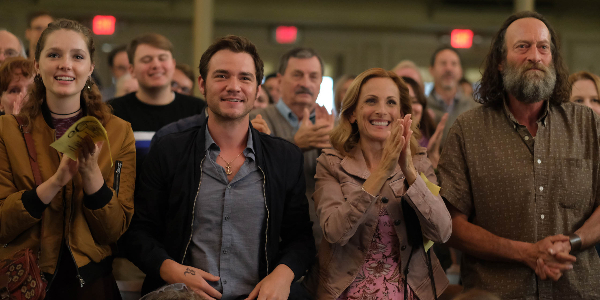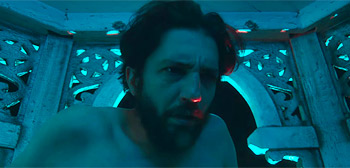IDFA 2020 Part 2: RADIOGRAPH OF A FAMILY, 100UP, A THOUSAND CUTS And WE ARE THE THOUSAND
Continuing with my coverage of the great films I saw at 2020’s International Documentary Film Festival of Amsterdam (IDFA), this article will cover the festival’s big winner Radiograph of a Family plus reviews of 100UP, A Thousand Cuts, and We Are The Thousand.
Radiograph of a Family (Firouzeh Khosrovani)
Radiograph of a Family may be the best family memoir documentary since Sarah Polley‘s Stories We Tell. Firouzeh Khosrovani‘s thoroughly engrossing, painfully personal film is a dissection of her parents’ love lives across the divides of their political and religious beliefs. Told entirely through a gorgeous personal photo archive, assisted with vintage footage of Iran in the 20th century, this documentary begins as a love story between the timid Tayi and the obstinate Hossein, who get married before they even meet. Tayi literally marries Hussein’s photo when he’s busy studying radiology in Switzerland whilst she remains in her homeland. It’s the odd couple tale of the secular progressive Muslim partnered with the traditional devout Muslim.
They meet and travel together around the world and, along their journey, he convinces her to take her headscarf off in a not-so-subtle attempt to “modernise” their image. But as she sees more of the world with him, she discovers the work of the late revolutionary sociologist Ali Shariati and becomes his student. From this encounter, her odyssey transforms into a period of deep self-actualisation as she finds her own identity and purpose within Iran, outside of being married to this radiologist.
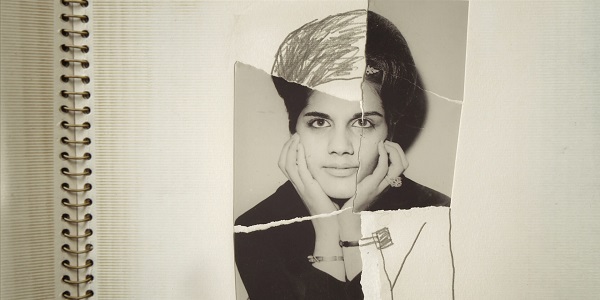
Personal development runs in parallel to sweeping cultural change – Khosrovani’s sharp writing, which imagines the dialogue between her mum and dad, with the help of two actors to narrate, unravels what the Iranian Revolution meant for women across the country as well as what it meant for this specific woman. It feels like an education in history – a feminist perspective of the Iranian revolution – as much as it feels like a personal catharsis for the filmmaker.
We see footage of women at protests, undertaking self-defense drills with AK47’s, and Tayi’s arc completed in the sole image of her wearing her scarf again. It all amounts to a film that’s both epic and intimate in scope, presenting the joy and sorrow of a relationship placed in the wider context of a country in motion. The fine dialogue that plays over the images by two excellent narrators gives the film an unexpected entertainment value, bringing it close to the realm of scripted narrative fiction in all the best ways, complete with a great finale.
100UP (Heddy Honigmann)
Sorry Michael Apted, Heddy Honigmann has only gone and raced ahead of you by about 40 years. An unofficial spin-off of the Up series (which saw its most somber chapter yet with 63 Up), the pleasantly warm 100Up looks at the daily lives of a handful of centenarians to examine what life means at that grand old age.
The issue with Honigmann’s film compared to Apted’s blueprint series, though, is that half of the subjects are relatively famous. There’s sex therapist Shirley Zussman, who became known in the Swinging Sixties and was eventually invited by Oprah to discuss her work on TV, and who formed half of a power couple with Leon Zussman, a doctor famed for performing one of the first legal abortions in New York. Then there’s Irwin Corey, a fellow New Yorker and retired stand-up comic who was affiliated with a who’s who of 50’s/60’s icons including fellow comedian Lenny Bruce, acclaimed author Thomas Pynchon, and the one and only Fidel Castro.
On the other end of the fame spectrum, we have subjects whose fame was birthed only after they turned 100something due to their continually productive lifestyles – Peruvian doctor Raúl Jerí continues to regularly work at the hospital at his remarkable age and Austrian immigrant Mathilde Freund caught the New York Times’ attention for using her late years to sell vintage clothes and jewelry every Sunday in the Big Apple.
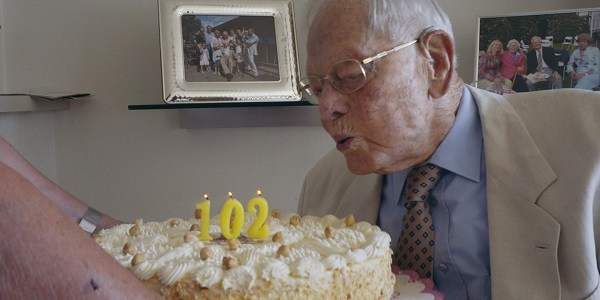
It’s interesting to hear conclusions drawn about destiny: Mathilde’s daughter died of breast cancer aged 50, and Mathilde believes that the children of Holocaust survivors are more likely to be ill based on her observation and experience. L.A.-based drummer Viola Smith, who grew up in a large musical family, predicates her entire career on the order of which she was born, realising that she could have been a violinist or guitar player if she was born even just one year earlier or later. Knowing the potential for strong sociological analysis in such a study, as evidenced in the Up series, which succinctly draws conclusions based on social class, I would have appreciated the perspectives from more ordinary, non-famous subjects.
However, I acknowledge that we are not quite at the point where living past 100 is normal and therein lies the film’s value, regardless of the diversity in subjects. Sweet and enlightening, 100UP is therapeutic for our existential health as we learn what really matters in life from those who have made it so far, and the values and lessons are relatable. Naturally, the three keys ones are: it’s so important to exercise, always take the opportunity to make connections, and stay close with family if possible.
A Thousand Cuts (Ramona S. Díaz)
A Thousand Cuts is a terrific film about Filipino journalist Maria Ressa, founder of the website Rappler, who has consistently spoken truth to power during the Duterte regime. For her courage and honest reporting, she has encountered a ton of hostility – and a lot of support too – culminating in an arrest. She was charged with cyber libel and found guilty earlier this year. It was a dark day for democracy and press freedom.
Filmmaker Ramona S. Díaz puts her characters – often famous Filipinos – at the heart of each of her documentaries, closely following them to the extent that it doesn’t feel so much as a simple observation but rather embedment in the life of her subjects. It was how she approached her film about former First Lady Imelda Marcos, Journey frontman Arnel Pineda, and now Maria Ressa. This intimate level of filming keeps Ressa front and centre, an approach that differs considerably to Marc Wiese’s We Hold the Line, the other Ressa biopic on the doc festival circuit that A Thousand Cuts will inevitably be compared to.
Díaz‘s film is stronger because it allows for a richer exploration of Ressa’s incredible character, as we understand her on a very personal level, especially in the scenes when we see her with her family, knowing the endangerment to her life. The film is a testimony to her bravery. On the other hand, Wiese’s interaction with Ressa is more compressed, lucky enough to find interview slots with the journalist whereas Díaz is seemingly given carte blanche.
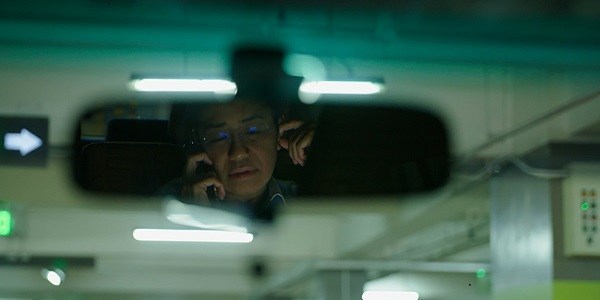
However, both have great value as investigative reporting because We Hold the Line primarily draws from poignant interviews with everyday folks whose lives have been affected by the violent drug war, whereas the higher budget A Thousand Cuts affords to join other high profile figures on their campaign trails as well as Ressa, such as Mocha Uson and the wildly popular Bato, two Duterte offshoots making a bid for various public positions, to form a panorama of the Philippines today in the context of populism and fake news.
A Thousand Cuts goes deep in unpacking the effects of digital data, utilising the same sort of compelling animations of The Great Hack to demonstrate how misinformation and hate campaigns spread on social media, analysing how Rappler was targeted by these tactics. Despite the support and acclaim, Ressa receives for her work, there’s a palpable dread throughout, summed up by George and Amal Clooney telling her how the international activist community is nervous about her return to the Philippines. Whilst the general rule of film is to leave on a note of hope, this one fills us with pessimism. But maybe that’s what it will take to rally audiences into helping Ressa and other compromised truth-tellers in any way in our small capacities.
We Are The Thousand (Anita Rivaroli)
Ambitious Italian geologist Fabio Zaffagnini pulled off the greatest celebration of music when he engineered 1000 of his countryfolk to congregate in their small hometown of Cesena, Italy, and collectively perform the Foo Fighters’ Learn to Fly (the easiest song to learn according to Fabio’s anointed guitar guru Claudio). They intended to dispatch the video online and hopefully attract Dave Grohl’s attention. Spoiler alert – their plea was heard and the rock band came down to perform in this modest little municipality.
The film moves very, very quickly, from quick biographical notes of the major players involved in the operation to the planning of the day, to the viral success and so on, culminating in a wider view of the Rockin’ 1000 music group that was formed out of the Learn to Fly success. This group continues the theme – in various cities around the world, one thousand musicians collaborate for epic performances of iconic songs such as Smells Like Teen Spirit and Seven Nation Army. There’s an extremely high chance that you will have seen one of these covers even if you don’t know the organisation’s name.
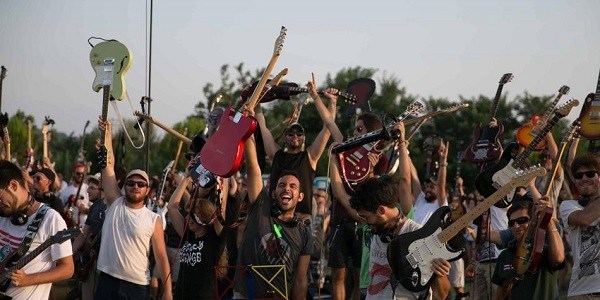
The fast pace of storytelling constantly left me hanging with the sort of questions that may make people question if I’m fun at parties: was Fabio able to easily reach out to one thousand people because he had a big preexisting network? What did the marketing campaign look like? Fabio says he worked on the event for one year – what were some of the obstacles he faced along the way? Why specifically the Foo Fighters rather than some of the other mega rockers who have never played in Cesena? Lots of basic but, in my view, significant questions that go unanswered.
Ultimately, though, I frankly didn’t care about the administrative or personal details by the end. A rapid montage in which dozens of performers listing their diverse occupations was sufficient enough to highlight the power of music to connect us no matter how different we are. It is an absolute joy to watch this disparate group of people rehearse together. We Are The Thousand is achingly nostalgic in this particular time: watching the gathering of a large community, collectively bonding over an artistic experience, euphorically bound together to make history. It’s hard for me to think of the last film I saw that made me feel so good and so sad at the same time.
Side note – I’m convinced that this film is sponsored by Ray Ban. There’s no other explanation for it apparently being the only choice of eyewear for hundreds of people.
Stay tuned for part 3 of my IDFA reviews and click here to read part 1.
Does content like this matter to you?
Become a Member and support film journalism. Unlock access to all of Film Inquiry`s great articles. Join a community of like-minded readers who are passionate about cinema – get access to our private members Network, give back to independent filmmakers, and more.
Join now!
